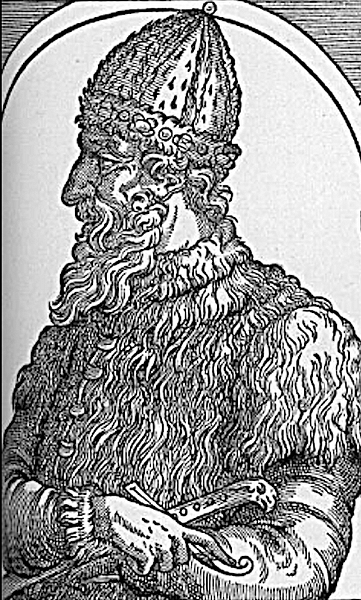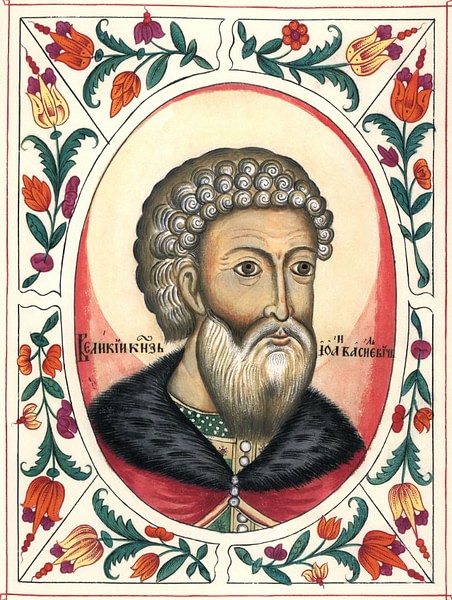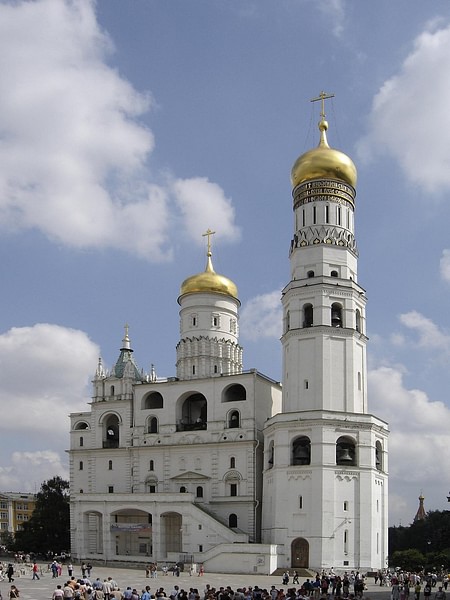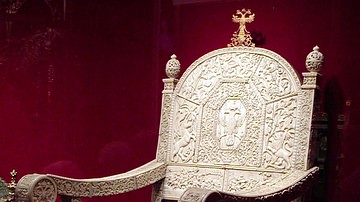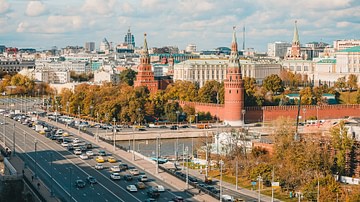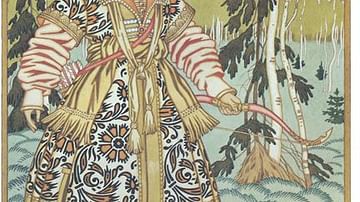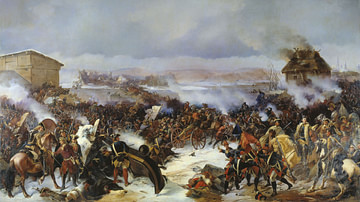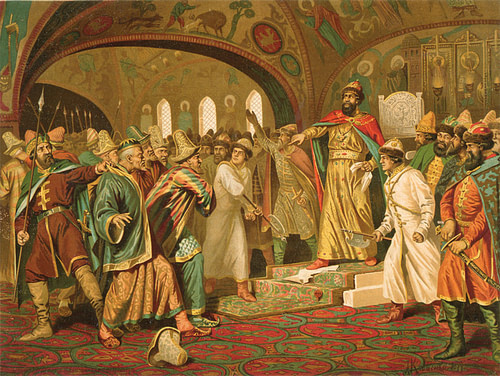
Ivan III of Russia (Ivan the Great) was the Grand Prince of Moscow and Russia from 1462 to 1505. Ivan III was born in 1440 to Grand Prince Vasily II of Moscow (r. 1425-1462) and his wife, Maria Borovsk (l. c. 1420-1485). He served as co-ruler for his blind father from 1450 until he became regent in 1462.
Ivan III was the first Russian ruler to be given the title 'the Great', which was bestowed upon him for his success in uniting most of Russia, expanding Russian lands, and removing the power the Mongol Golden Horde had over Russian rulers. Ivan III was also the first to begin signing documents with 'tsar'. However, he was never formally crowned as one. Ivan III's main goal during his reign was to unify the Russian states, which he succeeded in doing.
Birth & Co-Regency
Ivan III was born on 22 January 1440 to Grand Prince Vasily II and his wife, Maria Borovsk. According to legend, the bishop of the state of Novgorod received an ominous message from an old monk who stated that Moscow was celebrating the birth of the new prince who would one day rule over many princes and be a great prince.
In 1446, Vasily II was attending midnight mass at the Church of the Trinity in the Kremlin when he was attacked by conspirators and imprisoned in a palace. A few days after he was captured, his eyes were brutally ripped out, and he was sent away to another city while his children were sent to a convent. Vasily II eventually gained power with the help of his supporters, but now blind, he needed assistance from his oldest son, Ivan III. Ivan III became co-ruler and regent for his father in 1450. In 1462, Vasily II died, and Ivan became Grand Prince at 22 years old.
Marriage to Sophia Palaiologina
Ivan III was married at a young age to Maria, a princess of Tver (a Russian medieval state). They had a son called Ivan Ivanovich (r. 1471-1490). Maria of Tver died in 1467, and Ivan III decided to marry again to secure his dynasty. His new bride was Sophia (Zoe) Palaiologina (l. c. 1449-1503), the niece of the last Byzantine emperor, Constantine XI (r. 1449-1453). Their wedding in 1472 was a lavish affair that was said to have rivalled the grand weddings of the Byzantine Empire.
The Russian people viewed the wedding of Ivan III and Sophia Palaiologina as a sign that the Russian Orthodox Church was the successor of the Greek Orthodox Church. His new wife inspired Ivan III to make changes that would impact Russia for hundreds of years. Ivan III would use the double-headed eagle, originally seen in the Byzantine Empire, as Russia's coat of arms. He also implemented Byzantine ceremonial traditions in his own court.
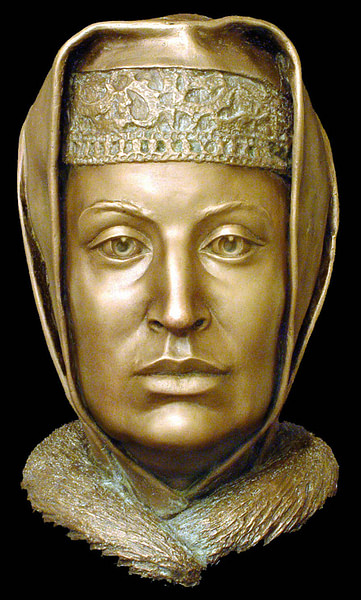
Novgorod
Novgorod was a powerful Russian medieval state that was run by boyars (Russian nobility) and wealthy merchants. The common people of Novgorod were tired of being looked down upon by the wealthy and being treated like second-rate citizens and were in favour of Novgorod being annexed to Moscow. They were supported by some boyars, the clergy, and Moscow's agents who secretly sent funds to them. However, most of the wealthy population opposed being united with Moscow and preferred to be kept as an independent state.
In 1471, the boyars signed defence treaties with Poland and Lithuania to defy Moscow. Taking it one step further, the boyars then demanded that the land taken by Vasily II be returned to them. Ivan III did not take kindly to these actions by the boyars and led an army to Novgorod, where he laid siege to the city. The Novgorod army marched out to face Ivan III's army, but they were no match for them. Some regiments even refused to fight against Ivan III, and before too long, he had taken the city.
The nobility and clergy pledged an oath of loyalty to Ivan III and his heir. As punishment for their actions, they had to nullify their defence treaty with Poland and Lithuania, give up territories to Ivan III, and agree that all archbishops of Novgorod would be appointed by the Metropolitan (Archbishop) of Moscow. To secure their continued support, Ivan III gave more money to the pro-Moscow groups. He left Novgorod, confident that they were now entirely loyal to him.
Ivan III returned to Novgorod four years later to cheers and large crowds. His goal was to silence the nobles who were still opposed to his rule. He set up a royal court and imprisoned those who were most vocal. This action stirred up more hostile feelings towards Ivan III, which was just what he had hoped for. Ivan III kept meeting with representatives from Novgorod. At one fateful meeting, they addressed him as 'sovereign' instead of the usual 'lord'. Ivan III asked if they recognised him as a sovereign, knowing that if they did, it would end Novgorod's independence.
Ivan III promised that as a sovereign, all citizens of Novgorod would be under his protection, but in return, Yaroslav Palace, which was in the centre of the city, would become the residence of his governor. In the past, governors sent to Novgorod had lived outside of the city, limiting their interactions with the people of Novgorod and minimising the impact they had. The Novgorod representatives decided they should talk to the veche (legislative authority) before agreeing with Ivan III's terms.
After many debates and arguments, the people of Novgorod were ready to tell Ivan III their decision. Much to his disappointment, they told him that they would recognise him as their lord but not as a sovereign and that his governors would not be allowed to interfere in Novgorod's politics. Ivan III was furious and immediately declared war on Novgorod. In November 1478, Novgorod was again under siege by Ivan III and his army. It took less than two weeks before the archbishop and boyars approached Ivan III and sued for peace, knowing that they would be defeated, especially after the Grand Prince of Lithuania refused their calls for military assistance.
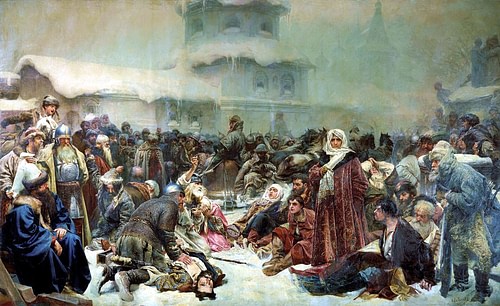
In a desperate attempt to retain their independence, they offered to pay him a large tribute every year in return for them being able to keep their own legal system. Ivan III refused their terms and told them that the siege would end when Novgorod stopped electing their own governor and after the bell used for veche meetings was removed. The delegates were given time to confer with the veche and ultimately surrendered. Once again, Ivan III held court where boyars who had opposed him were tried and some executed. Ivan III took the bell that had symbolised Novgorod's independence back with him to Moscow.
Novgorod recognising Ivan III as their sovereign was a significant turning point for Ivan III's goal of a unified Russia. However, Ivan III failed to view Novgorod as a successful commercial centre and did not take full advantage of its strategic location on the Baltic coast. It was not long before Novgorod turned into another Russian backwater. During his long reign, Ivan III also succeeded in annexing Yaroslavl in 1463, Dmitrov in 1472, and Rostov in 1474.
Ivan III & the Golden Horde
Moscow had been a tributary of the Mongol Golden Horde for many years, which continued during the beginning of Ivan III's rule. The Golden Horde was split into three main groups. The western group occupied land that included the Volga and Kama Rivers (known as Kezan). As more of Russia was united under one ruler, Ivan III was determined to regain this land and free Russia from Mongol rule for good. He took the risky step of refusing to send a gift to Khan Ahmed bin Küchük (r. 1465-1481). The khan responded by ordering Ivan III to present himself at Sarai (near the Caspian Sea). Realising that he would be in danger if he appeared in person before the khan, Ivan III instead chose to send him some gifts to appease him.
In 1478, the khan sent messengers to Ivan III, instructing him to pay back taxes and tributes. Ivan III tore up the letter and executed the messengers except for one who was to deliver a warning to the khan. The Golden Horde knew that they could not defeat the Russian army on their own, so they turned to Lithuania for help. In 1480, the khan signed a treaty with Casimir IV, Grand Duke of Lithuania and King of Poland (r. 1440-1492), with the Golden Horde agreeing to invade Russia from the south while the Lithuanian army invaded from the west.
In September 1480, the Golden Horde marched towards Russia. Ivan III gathered a large army together but realised he needed additional help. He asked the Crimean Horde to attack Poland to distract the Lithuanian army. The Golden Horde and the Russian army met on opposite banks of the Ugra River. The river started to freeze over in October, and Ivan III was tempted to flee but was stopped by his son. The Russian army retreated to the hills, which offered more protection. Khan Ahmed refrained from following them as he feared they might be led into a trap.
A messenger from Sarai arrived to inform the khan that his capital was under attack by the Crimean Horde and the Russians. The Golden Horde immediately returned to Sarai but soon discovered that the "attack" was only a trick to lure them away from the Ugra River. Khan Ahmed was quickly killed after returning to Sarai, and his successor died in 1500, marking an end to the Golden Horde and their hold over Russia.
Tver
Tver was considered a longtime adversary of Moscow and ruled by Prince Mikhail III of Tver (r. 1461-1485), the only Russian prince to rival the power of Ivan III. Mikhail III had signed a peace treaty with Casimir IV, which enraged Ivan III and caused him to send an army to Tver. Mikhail III quickly renounced the peace treaty and stated that he was loyal to Ivan III. A few years later, Mikhail III attempted to re-sign the treaty with Casimir IV, but Ivan III's agents intercepted his messages. Another army marched towards Tver, with Mikhail III fleeing to Lithuania. It did not take long for Tver to fall to Ivan III in 1485. Mikhail III died shortly after, most likely at the hands of Ivan III's men.
Lithuania
After Casimir IV died in 1492, Poland and Lithuania split and Casimir's son Alexander (r. 1492-1506) was appointed Grand Duke of Lithuania. Ivan III proposed a treaty that would return territory along the Russian-Lithuanian border. Alexander agreed and acknowledged Ivan III as Russia's sovereign and married his daughter Helena of Moscow (l. 1476-1513) to cement their good relationship further.
The friendly relations between Russia and Lithuania soon came to an end after the territories started swearing allegiance to Russia instead of Lithuania. Helana also complained to her father about how her husband treated her, causing further conflict. Once again, Ivan III enlisted the help of the Crimean Horde, while the Livonian Knights sided with Alexander. The battle ended when Russia captured the Lithuanian military commander. In 1503, the treaty between Russia and Lithuania was reinstated.
A Unified Russia
Ivan III's dream of uniting Russia during his reign was largely successful. He became the first ruler of a unified Russia free from the Golden Horde. He began referring to himself as a tsar, although he would not be formally crowned as one. A new government was needed to ensure that Russia ran smoothly. A council of boyars was made up of nobles who had previously ruled their own territories but now served Ivan III. They were not a formal part of the Russian government, but they still had a lot of power.
Ivan III started giving away land that once belonged to the Golden Horde, the Lithuanians and the people of Novgorod to those who volunteered for military service. This created a new class of society called the servitors (pomeshchiki). Ivan III ensured that he could gather a large army quickly when needed and be able to reward them without having to empty the treasury.
In 1497, the Code of Laws (Sudebnik), Russia's first standardised legal system, was created. It established Ivan III's great power over all Russian citizens, from officers to peasants. However, Ivan III also knew he would need to win over the common people. He opened up the palace and made himself accessible so he could listen to their complaints.
Moscow As the Third Rome
Moscow became known as the 'third Rome', and inspired by his wife and the Renaissance, Ivan III decided that Moscow needed to reflect its importance as the new successor to Tsargrad and the capital of Russia. He invited Italian architects to work on the Kremlin, Moscow's fortress and the centre of Russian royalty, government, and defence.
The most famous buildings that were built during Ivan III's rule include the Dormition Cathedral (Assumption Cathedral), which was consecrated in 1479 and is considered one of Moscow's most sacred cathedrals, the Grand Ducal Palace (1514), and the beautiful Chamber of Facets (Palace of Facets), which was completed in 1492. A new Cathedral of the Archangel (1508), the future burial place of many royals, was also constructed. However, Ivan III died three years before it was completed and never got to see the end result. The Ivan the Great Bell Tower was completed in 1508 by architect Bon Fryazin. It is the tallest structure in the Kremlin, playing a crucial role in the defences of the Kremlin as its central watchtower.
Ivan III helped Moscow grow to rival the size of major cities like Florence and Prague, and it became a worthy capital city of the new unified Russia.
Death & Legacy
When it came to choosing a worthy successor, Ivan III was conflicted between choosing his grandson Dmitri Ivanovich (r. 1498-1502) from his first marriage or his son with Sophia, Vasily III (r. 1505-1533). After fighting with Sophia, Ivan III chose his grandson as his heir in 1498. Dmitri was crowned as grand prince, but his mother, Princess Elena of Moldavia, fell out of favour with her father-in-law. Ivan III removed him as grand prince in 1502 and named his son, Vasily III, as his heir instead. Ivan III died in his bed on 27 October 1505. His death was not particularly mourned, as he had distanced himself from his family, and he had many enemies who were opposed to him unifying Russia.
Besides unifying most of Russia, Ivan III introduced new traditions that would last into the 20th century. First, that all tsars had the divine right to rule, and second, he implemented many Byzantine royal rituals that would see him placed on a pedestal and more isolated from the common people.

